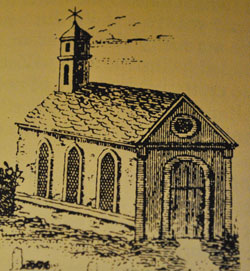
We have covered rites of passage marked by colonial churches—birth, initiation and marriage. Last half of death this week:
Because of the frequency of death, a culture of death grew up around objects – mourning attire, mourning rings, the family Bible and a funeral banquet, several which are foreign to us today. They provided a way to remember loved ones and reassert the necessity of survival – in a sense creating a community of mourners. Hair in mourning rings was a substitution for the departed. Lists inscribed in treasured family Bibles in a sense replace the chil¬dren whose short lives were narrated there
Mourning clothing of the sort worn in colonial Virginia had antecedents in the Middle Ages, when elite mourners wore black clothes (although other colors, including brown and red, were also considered proper for mourning). The clothes were worn men participating in burial rites and close relatives. First Mourning lasted where black was worn. Second Mourning last another three months colors shifted to grays. Mourning rings grew popular in the colonial period with rings color reflecting that of the mourning clothes. Wills spelled out who was to get the rings.
Family Bibles were part of mourning – reasserted family unity and survival and were a way for church tasks to be brought home. The choice to keep family records in a Bible was doubtless driven by practicality: paper was not readily available, so it made sense to record one’s records in the white spaces of a book one already owned. Bibles had collections of genealogies anyway.
 Mourning ring engraved George, Martha Washington with their hair
Mourning ring engraved George, Martha Washington with their hair
Death was a great drama in the colonial period. Deathbeds were not spaces dominated only by close kin, and deathbed scenes were not necessarily intimate. Rather, the deathbed was a more broadly social scene, in which clergy and neighbors participated. Clergymen regularly visited the sick, sometimes leaving home in the middle of the night to celebrate Holy Communion at a parishioner’s bedside.
The funeral rituals had four central elements: a burial, a meal, a liturgy, and a sermon
The burial service employed more collects, prayers, psalms, and scripture selections than today’s service to place the reality of death in the context of the faith and teachings of the church with its proclamation of resurrection and another life beyond death. The burial service could not be used for those where “unbaptized, or excommunicate, or have laid violent hands upon themselves.”
Typically there was a full sermon at death expositions of an appropriate scripture text, not simply eulogies to the departed. There was significant attention given to these sermons and tended to be an education in themselves. John Thompson of St. Mark’s Parish preached on discourses on sin and judgment, the right use of time, true repentance, and righteous living, a call to faithful attendance upon one’s religious duties, and a vigorous affirmation of the promised resurrection.
Virginia clergymen’s funeral sermons made three main points about death and salvation from the pulpit. First, salvation was not absolutely as¬sured. Second, salvation came from God but was related to living a good and holy life (whether the parsons were suggesting that a good and holy life testified to or earned salvation is not entirely clear). Third, parishioners should not postpone repentance until just before death. They were trying to inspire parishioners to lead good and holy lives.
After the service there was the burial – Given the distance between the church and the house due to the size of parishes, families wanted beloved decedents to be interred near the home so that mourners could visit graves easily. Household burial was also a mark of status since it was clear that the decedent was a propery owner. Finally there was the desire to be resurrected with one’s own kin.
The Anglican church did not monopolize burial as it did over marriage. Dissenting denominations—at least those with licensed clergy and authorized meetinghouses—were free to bury their own according to the rites and customs peculiar to each.
Finally a large meal was served at the home after the church service and burial. (Today the reception in the Church is similar to this ). These meals served the purpose of reminding the living that they were indeed alive, that life went on and helped to bring them back to their normal lives. The standard funerary meal consisted of "funeral biscuits" or "mourning biscuits" and wine. The biscuits were probably molasses seasoned with caraway and ginger and often shaped in the design of a heart or cherubim. The funeral biscuits were typically dipped in alcohol before being consumed.
